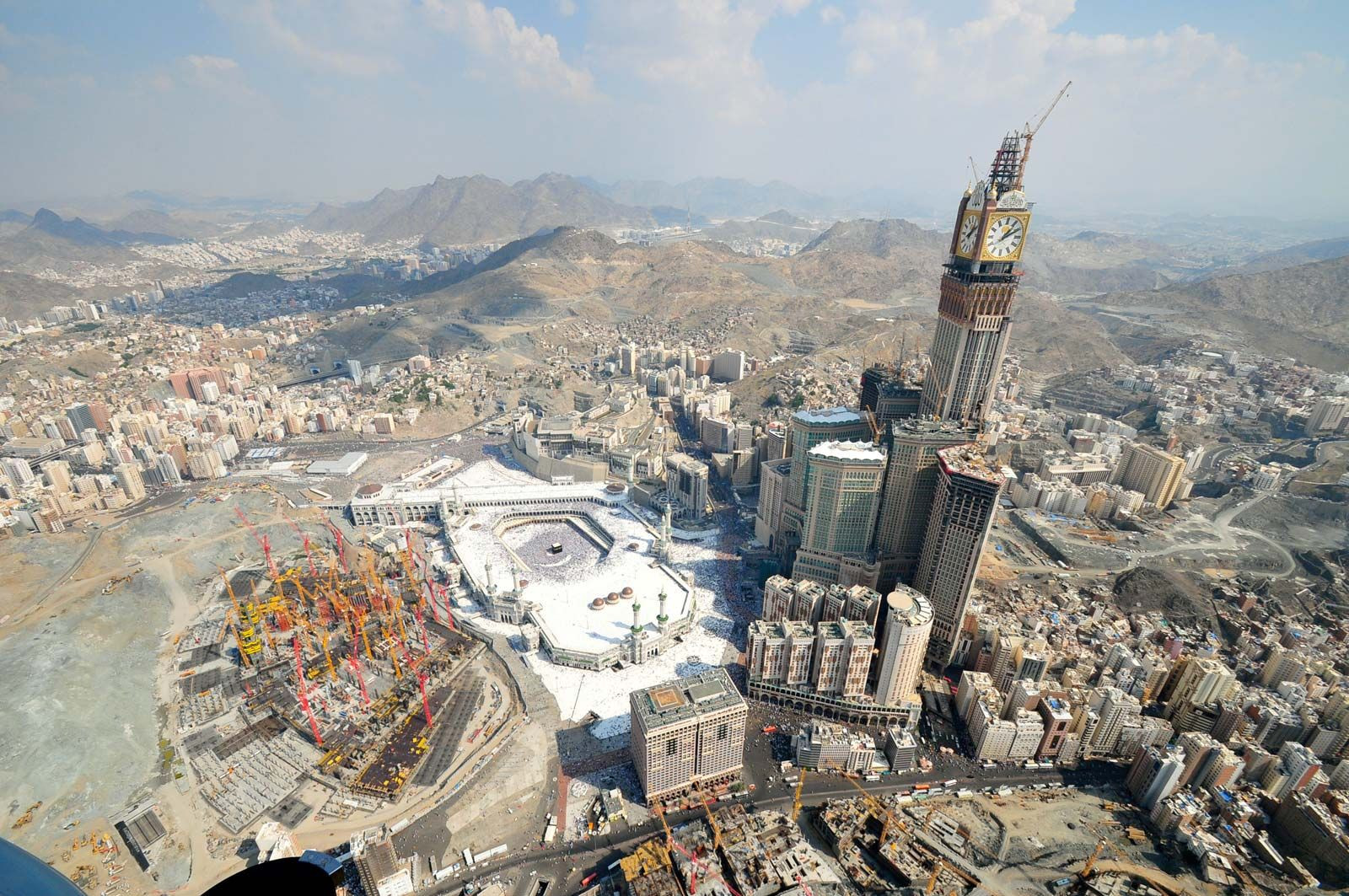Mecca, often transliterated as Makkah, holds an unparalleled position in the Islamic world. It is the holiest city in Islam, the birthplace of the Prophet Muhammad, and the direction (Qibla) towards which Muslims pray five times a day. But Where Is Makkah exactly? Nestled in the Hejaz region of Saudi Arabia, Makkah is more than just a point on a map; it is a city steeped in history, faith, and geographical significance.
Geographical Location and Landscape of Makkah
Makkah is geographically positioned in a valley within the Sirat Mountains in the western part of Saudi Arabia. To pinpoint where is Makkah in terms of altitude, it sits at an elevation of 909 feet (277 meters) above sea level. The city developed in the arid beds of Wadi Ibrahim, a dry river valley, and its several smaller tributaries. This unique location is defined by the dramatic mountainous landscape that surrounds it.
The Mountains Defining Makkah’s Location
The Sirat Mountains are integral to understanding where is Makkah. These peaks not only form a stunning backdrop but also historically shaped the city’s boundaries and access points. Among the prominent peaks are:
- Mount Ajyad (Jabal Ajyad): Rising to 1,332 feet, located to the east, offering panoramic views of the city.
- Mount Abu Qubays: Reaching 1,220 feet, also to the east, another significant peak in the cityscape.
- Mount Qu’ayqa’an: Reaching 1,401 feet to the west, further enclosing the city within its mountainous embrace.
- Mount Hira (Jabal Hira): Towering at 2,080 feet to the northeast. This mountain holds immense religious importance as it houses the Cave of Hira. It was in this cave that Prophet Muhammad received his first revelation of the Quran, marking a pivotal moment in Islamic history.
 Panoramic view of Mecca, Saudi Arabia, showcasing the mountainous terrain
Panoramic view of Mecca, Saudi Arabia, showcasing the mountainous terrain
Entry Points to Makkah Through Mountain Passes
Historically, access to where is Makkah was determined by four key mountain passes. These gaps in the Sirat Mountains facilitated entry and exit, and even today, they influence the directions of the city’s expansion:
- Northeast Pass: Leading towards Mina, Arafat, and Al-Ta’if, crucial sites for the Hajj pilgrimage.
- Northwest Pass: The route to Medina, the second holiest city in Islam.
- West Pass: Connecting Makkah to Jeddah, the major port city and gateway for pilgrims arriving by air and sea.
- South Pass: The road towards Yemen, linking Makkah to the southern regions.
These natural corridors have not only dictated the historical routes to where is Makkah but continue to guide the modern urban development of the city.
Climate of Makkah: Aridity and Heat
Understanding where is Makkah also involves considering its climate. Situated in a low-lying area, Makkah experiences an arid climate characterized by high temperatures and minimal rainfall. Despite the low annual precipitation, the city is susceptible to seasonal flash floods due to its valley location.
Temperature and Rainfall Patterns
- Rainfall: Makkah receives less than 5 inches (130 mm) of rainfall annually, primarily during the winter months. The scarcity of rain underscores the desert environment.
- Temperature: Temperatures remain high throughout the year. Summers can be extremely hot, often soaring to 120 °F (49 °C). This intense heat is a defining feature of Makkah’s climate.
Plant and Animal Life in Makkah’s Arid Environment
The harsh climate of where is Makkah significantly impacts its natural flora and fauna. Plant and animal life is sparse, consisting mainly of species adapted to survive in conditions of extreme aridity and heat.
Vegetation and Wildlife
- Natural Vegetation: Dominant plants include hardy species like tamarisks and various types of acacia trees, which are well-suited to the dry environment.
- Wild Animals: Wildlife is limited but includes resilient creatures such as wild cats, wolves, hyenas, foxes, mongooses, and kangaroo rats (jerboas). These animals have adapted to the challenging desert conditions around where is Makkah.
City Layout: The Haram Mosque and Urban Expansion
The heart of where is Makkah is undoubtedly the Haram Mosque, also known as the Great Mosque. This central point houses the Kaaba, the holiest site in Islam, and the sacred Well of Zamzam. The city’s layout has historically and continues to radiate outwards from this sacred center.
The Central Haram and Urban Growth
- The Old City: The compact urban area immediately surrounding the Haram Mosque constitutes the old city. It extends primarily to the north and southwest, constrained by the mountains to the east and west. Key avenues in the old city include al-Mudda’ah and Suq al-Layl to the north, and al-Suq al-Saghir to the south of the mosque.
- Modern Expansion: Since World War II, where is Makkah has expanded significantly along the roads that pass through the mountain gaps, particularly to the north, northwest, and west. Modern residential areas like Al-Aziziyyah, Al-Fayzaliyyah, Al-Zahir, Al-Zahra’a, and Shari’ al-Mansur have developed along the routes to Mina, Jeddah, and Medina.
Modernization Around the Haram Mosque
In the 21st century, the area around the Haram Mosque has seen dramatic modernization. Skyscraper hotels and complexes like Abraj Al-Bayt have been constructed to accommodate the increasing number of pilgrims. The Haram Mosque itself has undergone massive expansions, becoming a state-of-the-art, multilevel complex equipped with advanced amenities to host millions of worshippers. This transformation reflects the evolving landscape of where is Makkah while preserving its historical and religious core.
Housing in Makkah: Traditional and Modern
Housing in where is Makkah varies between the old city and the newer residential areas. The old city features more compact housing, while modern areas offer more spacious accommodations.
Housing Styles
- Traditional Housing: In the old city, buildings are typically two or three stories high, constructed from local rock, reflecting traditional architectural styles adapted to the climate.
- Modern Housing: Modern residential areas feature villas and apartment buildings made of concrete, catering to contemporary living standards.
Housing Challenges and Pilgrim Accommodation
Despite modern developments, areas of impoverished housing exist, often inhabited by pilgrims who stayed in where is Makkah after the Hajj or Umrah due to financial constraints. Addressing housing needs for both residents and pilgrims remains a continuous challenge in the city.
People of Makkah: A Cosmopolitan Population
The population of where is Makkah is characterized by high density, particularly in the old city. Modern residential areas have lower densities compared to the city center.
Population Dynamics and Diversity
- Population Density: High concentration of residents in the old city, with lower densities in modern areas.
- Pilgrimage Influx: During the Hajj month, the city’s population swells by one to two million worshippers from around the world, highlighting Makkah’s global religious significance.
- Cosmopolitan City: Despite entry restrictions to Muslims only, Makkah is a highly cosmopolitan city, hosting people from diverse national backgrounds. Communities often form based on national origin within the city, adding to its rich cultural mosaic.
In conclusion, where is Makkah is not just a geographical question but an exploration into the heart of Islam. Its location in the valley of Wadi Ibrahim, surrounded by the Sirat Mountains, its arid climate, unique urban layout centered around the Haram Mosque, and its diverse population all contribute to the distinctive character of this holiest of cities. Makkah stands as a testament to its historical, geographical, and spiritual significance in the world.

